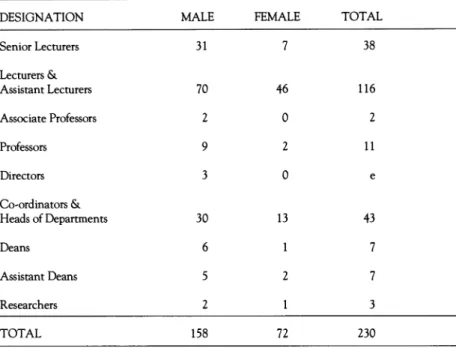RESEARCH REPORT
THE IMPACT OF WOMEN IN MANAGEMENT IN HIGHER
EDUCATION (HE) ON WOMEN UNDERGRADUATES AT THE
UNIVERSITY OF GUYANA (UG)
CLAUDETTE COLLETTE AUSTIN University of Guyana
Guyana is one of the smaUer less developed countries located geographi-caUy on the South American mainland. It has historic, social, cultural and economic links with the Commonwealth Caribbean, having been a British Colonial possession from 1803 to 1966 when it gained political independ-ence. lt comprises three counties: Essequibo, Demerara and Berbice. The overaU position of women in Guyana is govemed by ethnic, economic, political and socio-cultural factors. Although women are employed in aU spheres the number that occupy senior or top management positions in higher education is smaU.
This study (Austin, 1998) examined the status of women students and managers at the Turkeyen campus of the University of Guyana (UG}.lt considered enrolment and graduation statistics of the six faculties to identify the pool of women eligible as employees for management at the university. The roles and responsibilities of women in managements toward women students between 1995 and 2000, were explored through formaI and infor-maI interviews with female lecturers, administra tors and students. The results were analysed against a review of the relevant literature.
Women students were a majority of those enroUed in some faculties: Social Sciences (66.4% women) and Education (80.7% women), Law (54%) ,Natu-raI Sciences (46.9% women) and Technology (8.2% women). Women are, however, a minority of staff at the University of Guyana.
The Table (next page) shows how men predominate in academic positions at aU levels. This situation requires examination as women make up a majority of student enrolments.
The interviews revealed that in addition to basic qualifications criteria for staff appointment included qualities related to charismatic leadership and self-confidence. Women felt that they could not compete against such criteria. Longer years of service meant that men were more eligible for leadership positions Fewer women were eligible because of their compara-tively late entry into employment in the academy. Women tended to prefer teaching and managing at the department rather than the university level,
Claudette Collette Austin
TABLE 1: Academie positions at University of Guyana by gender 2001
DESIGNATION MALE FEMALE TOTAL
Senior Lecturers 31 7 38
Lecturers &
Assistant Lecturers 70 46 116
Associate Prof essors 2 0 2
Prof essors 9 2 11 Directors 3 0 e Co-ordinators & Heads of Depanments 30 13 43 Deans 6 7 Assistant Deans 5 2 7 Researchers 2 3 TOTAL 158 72 230
and women managers tended not to support each other. However a number of women staff working at departmentallevel felt their work at this level was exceedingly stressful. Sorne senior women administrators were content to serve as deputies and did not aspire to higher positions in the university. The small numbers of women in leadership undermined any significant representation of women's issues at decision-making forums
The data substantiate views (DeSimone, 1995; Hollenshead et a1., 2001; Hunt, 1998; and Morley, Unterhalter & Gold, 2002) that quantitative growth resulting from the feminisation of Higher Education is not an indication of qualitative growth in terms of employment in HE manage-ment. Inadequate scholarships and student loans for postgraduate study, plus persistent conflicts of child care and household responsibilities hinder wom-en's employment.
The study highlights the need for support through a range of schemes inc1uding mentorships and discussion forums to help women undergraduates and staff employed on low grades acquire the knowledge and skills that will motivate them to pursue academic careers. There is also a need for the University of Guyana to consider the structural barriers that hinder wom-en's progress, address inequalities in promotion and explore alternative promotion criteria that value the contribution women make.
The Impact of Women in Management in Higher Education
REFERENCES
Austin, C. (1998). Empowering women in management in higher education. MA Thesis. Institute of Education, University of London.
DeSimone, D. M. (1995). Charlotte Perkins Gilman and the Feminization of Education. In WILLA Volume 5 http://scholar.lib.vt.edu/ejoumals/WILLA/fa1l95/DeSimone.html <http:// scholar.lib.vt.edu/ejoumals/WILLA/fa1l95/DeSimone.html>
Hollenshead, C. S. & Miller, J. E. (2001). Diversity workshops: Gender Equity - A doser look. http://www.diversityweb.org/Digest/SpOl/research2.html<http://www.diversityweb.org/Digest/ SpOI/research2.html>
Hunt, L. (1998). Has the battle been won? The feminization of history, Perspecti\leS OnIine. http://www.theaha.org/perspectives/issues/1998/9805/9805VIE1.CFM<http://www.theaha.org/ perspectives/issues/1998/9805/9805VIE1.CFM>
Morley, L., Unterhalter, E., & Gold, A. (2002, July 25). Keynote address· Sound and silences: Gendered change in higher education institutions in the Commonwealth, 8th International Interdisciplinary Congress on Women, Mekerere University, Kampala, Uganda.
CLAUDETTE COLLETTE AUSTIN is a Lecturer Il in Educational Administration and Head. Department of Foundations and Education Management in the School of Education and Humanities, University of Guyana. She holds a Bachelor's Degree in Arts and a Diploma in Education from the University of Guyana as weil as a Masters degree in Women and Management in Higher Education from the Institute of Education, University of London. Prior to her appointment as a Lecturer in 1998 she worked for over a decade as an Administrator in the University of Guyana. Claudette has written courses in Issues and Perspectives in Education and Gender and Education Management for distance education delivery. She is currently carrying out research and writing on Gender Equity in Higher Education, Women and Management and current issues in education.
Depuis 1998, CLAUDETTE COLLETTE AUSTIN est maître de conférence en Administra-tion scolaire et dirige le département de Fondements et GesAdministra-tion en éducaAdministra-tion au sein de la School of Education and Humanities de l'Université de Guyana. Elle détient un Baccalauréat-ès-Lettres et un Diplôme en éducation de cette même université, ainsi qu'une Maîtrise portant sur les femmes et la gestion universitaire de l'institute of Education de l'Université de Londres. Avant sa nomination en 1998, ellea. pendant dix ans. oeuvré dans l'administration de l'Université de Guyana. Claudette est l'auteur de cours d'enseignement à distance portant sur les problèmes contemporains en éducation et sur la parité sexuelle dans les postes de direction en éducation. Ses recherches en cours touchent aux questions d'équité dans l'enseignement supérieur. à la place des femmes dans les postes de direction et à des questions qui se posent aujourd'hui en éducation.
